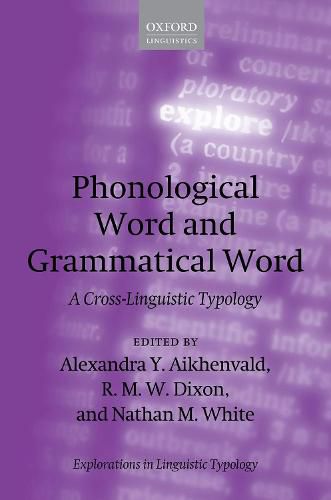Readings Newsletter
Become a Readings Member to make your shopping experience even easier.
Sign in or sign up for free!
You’re not far away from qualifying for FREE standard shipping within Australia
You’ve qualified for FREE standard shipping within Australia
The cart is loading…






This volume examines the concept of 'word' in its many guises and across many languages. 'Word' is a cornerstone for the understanding of any language: it is a pronounceable phonological unit; it has a meaning and a morphological structure and syntactic function; and it exists as a dictionary entry and an orthographic item. Speakers also understand 'word' as a psychological reality: they can talk about the meaning of a word and its suitability in certain social contexts. However, the relationship between the phonological word and grammatical word can be more complex, in that a phonological word can consist of more than one grammatical word, or vice versa. Following an introduction outlining the parameters of variation for phonological word and grammatical word, the chapters in this volume explore how the concept of 'word' can be applied to languages of diverse typological make-up, from the highly synthetic to highly analytic. The data are drawn from languages of Australia and the Pacific (Fijian, Yalaku, Yidin), the Americas (Chamacoco, Murui, Jarawara), Asia (Hmong, Japanese, Lao), and Africa (Makary Kotoko), with a final chapter that investigates the properties of 'word' from a cross-linguistic perspective. The volume advances our understanding of what constitutes a word, and will be a valuable resource for scholars and students of typology, linguistic anthropology, phonology, and grammar.
$9.00 standard shipping within Australia
FREE standard shipping within Australia for orders over $100.00
Express & International shipping calculated at checkout
This volume examines the concept of 'word' in its many guises and across many languages. 'Word' is a cornerstone for the understanding of any language: it is a pronounceable phonological unit; it has a meaning and a morphological structure and syntactic function; and it exists as a dictionary entry and an orthographic item. Speakers also understand 'word' as a psychological reality: they can talk about the meaning of a word and its suitability in certain social contexts. However, the relationship between the phonological word and grammatical word can be more complex, in that a phonological word can consist of more than one grammatical word, or vice versa. Following an introduction outlining the parameters of variation for phonological word and grammatical word, the chapters in this volume explore how the concept of 'word' can be applied to languages of diverse typological make-up, from the highly synthetic to highly analytic. The data are drawn from languages of Australia and the Pacific (Fijian, Yalaku, Yidin), the Americas (Chamacoco, Murui, Jarawara), Asia (Hmong, Japanese, Lao), and Africa (Makary Kotoko), with a final chapter that investigates the properties of 'word' from a cross-linguistic perspective. The volume advances our understanding of what constitutes a word, and will be a valuable resource for scholars and students of typology, linguistic anthropology, phonology, and grammar.